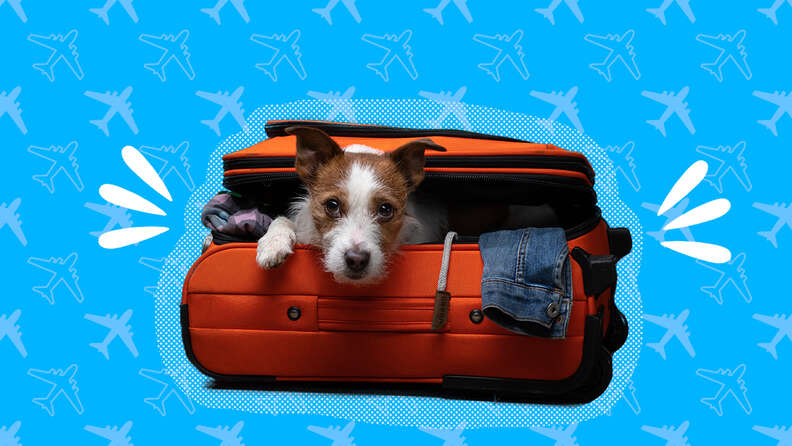Traveling internationally with your beloved canine companion can be an exciting adventure, but it also requires careful planning and preparation to ensure a smooth and stress-free journey for both you and your furry friend.

Credit: www.worldtrips.com
Before You Go:
Before embarking on your international journey, there are several essential steps to take to ensure that your dog is prepared and that you comply with the regulations of your destination country.
Health And Vaccination Requirements:
First and foremost, schedule a visit to your veterinarian to ensure that your dog is in good health and up-to-date on all necessary vaccinations. It is essential to obtain a health certificate from your veterinarian, as this document is often required for international travel with pets.
Microchipping And Identification:
Having your dog microchipped with an ISO compliant microchip is essential for international travel, as it provides a permanent form of identification. In addition to a microchip, consider attaching a durable collar with identification tags containing your contact information and the necessary travel details.
Research The Entry Requirements:
Each country has specific entry requirements for pets, including approved forms of identification, vaccination records, and import permits. Research the regulations of your destination country well in advance to ensure that you have all the necessary documentation and comply with their requirements.
Booking Your Travel:
When making travel arrangements, consider the most pet-friendly options available to minimize stress for your dog and ensure a comfortable journey. Whether you are traveling by air or sea, careful planning is crucial to ensure a safe and pleasant experience for your canine companion.
Air Travel Considerations:
When flying with your dog, choose a pet-friendly airline that provides accommodations for pets in the cabin or in a temperature-controlled cargo area. It is important to familiarize yourself with the airline’s pet policies and restrictions, including crate requirements, health documentation, and additional fees.
Sea Travel Tips:
If you are considering sea travel, research pet-friendly cruise lines and ferry services that allow dogs on board. Similar to air travel, acquaint yourself with the specific requirements and restrictions for traveling with pets on water-based transport to ensure a smooth and enjoyable journey.
Preparing for Departure:
In the days leading up to your departure, take the time to prepare your dog for the upcoming journey and minimize any potential stress or anxiety.
Acclimatize Your Dog To The Travel Crate:
Introduce your dog to the travel crate or carrier well in advance of your trip to allow them to become familiar and comfortable with their temporary confinement. Consider placing familiar blankets or toys inside the crate to create a sense of security for your dog.
Pack Essential Supplies:
Pack a travel kit for your dog, including a sufficient supply of food, water, medications, and any comfort items they may need during the journey. Additionally, bring along waste disposal bags, a leash, and your dog’s medical records and identification documents.

Credit: www.nytimes.com
During Travel:
As you embark on your international journey with your dog, there are several important considerations to keep in mind to ensure your pet’s well-being and comfort throughout the trip.
Hydration And Comfort Breaks:
Regularly offer your dog water and provide opportunities for comfort breaks during travel stops. It is important to keep your dog hydrated and allow them to stretch their legs and relieve themselves during layovers or rest stops.
Monitor Your Dog’s Behavior:
Observe your dog for signs of stress or discomfort during the journey, and provide reassurance and comfort as needed. Familiar scents, soothing words, and gentle petting can all help alleviate anxiety and reassure your dog during the travel experience.
Arrival and Beyond:
Upon reaching your destination, take the time to familiarize your dog with the new environment and ensure a smooth transition into your international travel destination.
Visit A Local Veterinarian:
Upon arrival, schedule a visit to a local veterinarian to ensure that your dog remains in good health in the new environment. This may also be an opportunity to address any necessary vaccinations or health requirements specific to the destination country.
Acclimate Your Dog To The Environment:
Allow your dog ample time to acclimate to the new surroundings, gradually introducing them to the local sights, sounds, and smells to minimize any potential stress associated with the change in environment.
Final Thoughts:
Traveling with your dog internationally can be a deeply rewarding experience, providing the opportunity to explore new destinations while sharing unforgettable adventures with your faithful companion. By adequately preparing and considering your dog’s well-being every step of the way, you can ensure a safe, comfortable, and enjoyable journey for both you and your furry friend.
Frequently Asked Questions On How To Travel With A Dog Internationally
How Can I Travel With My Dog Internationally?
To travel with your dog internationally, you need to ensure that you meet the destination country’s requirements for vaccinations, microchipping, paperwork, and quarantine if applicable.
What Vaccinations Does My Dog Need For International Travel?
Your dog will typically need core vaccinations such as rabies, distemper, and parvovirus. In addition, some countries may require specific vaccinations like leptospirosis or bordetella. Contact the destination country’s embassy or consulate for the most accurate information.
How Do I Get The Paperwork Needed For International Travel With My Dog?
Start by visiting your veterinarian, who will provide you with the necessary paperwork such as a health certificate and proof of vaccinations. You may also need to obtain an international health certificate from a USDA-accredited veterinarian.
Can I Bring My Dog As Carry-on During International Flights?
Many airlines allow small dogs to travel in the cabin as carry-on, but size and weight restrictions may apply. Be sure to check whether your selected airline permits in-cabin pet travel and follow their guidelines accordingly.



